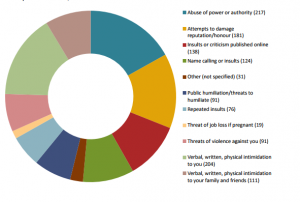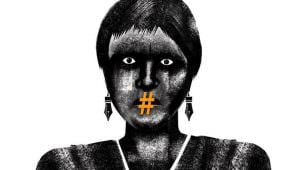Being a journalist in India means getting condescended upon for your opinion. Being a woman journalist in India means getting condescended upon for having an opinion.
While researching for this article, my first instinctive Google search was obviously ‘women journalists in Indian media’. And the result page was a symbol of the misfortune we bear as a species. An article about ’10 hottest female journalists in India’ was a moment of reality; that women are still largely perceived for the body they are in.

Source: Google
Women journalists have been actively involved in mainstream media for quite some time now, but seems like no amount of success is enough for them to expect respect for their work, and not face disrespect for their grit. Faye D’Souza was recently in the news for her unapologetic backlash over a sexist and humiliating remark made by Maulana Qasim. Although she received widespread applause for her move, this brings us to one question: Why is it so difficult for a woman to assert herself without getting humiliated?
When a female journalist asked 2013 Union Minister Valayar Ravi about the alleged role of Rajya Sabha Deputy Chairperson P J Kurien’s in Suryanelli gang rape case, she was in turn asked “Do you have anything personal against him? Did he do anything to you?” Multiple reasons can be gathered for such demeaning behaviour women have to face while practicing this profession.
The Unfeminine Traits
One reason is that women are always seen in terms of their physical features and domestic skills – and news reporting requires neither. Thus, when a woman shows traditionally masculine characteristics of assertiveness, boldness and confidence, people get uncomfortable.
In 2015, Minister of State for Information and Broadcasting Rajyavardhan Singh Rathore said that women in media would be better off pursuing off-field roles like that of news analysis as opposed to field reporting in view of safety, challenging conditions and odd hours of work. He denied making this statement after its social media outrage, but one can find such things said by politicians in abundance, especially when there’s a woman interrogating their deeds.

Early on, female journalists were typically limited to covering stories about women; Source: niemanreports.org
This leads us to the second reason, that of the prominent bias regarding the content of women reporters. They are expected to cover ‘soft’ issues like weddings, home decor, the ones confined to the domestic life, while stories of crime, corruption and other ‘hard-core’ issues are assumed unfit for a women reporter. This bias does a lot of damage to the press, as lack of women reporters also means lack of reporting about issues related to women, as well as their misrepresentation.
Not a Woman’s Place
Another reason is the sense of entitlement over women that people have internalized, and tend to automatically assume an upper-hand when interacting with them. If the woman does not let this entitlement muddle with her job, she is not allowed to succeed in it. Attempts are made to patronize, pester, and intervene in her work unnecessarily.
A global survey conducted by International’s Women Media Foundation (IWMF) reported a response they received from India, which said “gender discrimination is a major problem,” but especially for her, as a manager. “No one likes a female boss,” she said, “especially in the media field.”

Source: www.iwmf.org
Another report from the survey said that almost two-thirds (64.8%/597) of 921 respondents, all of which were women, answered “yes” to the question “Have you experienced intimidation, threats or abuse in relation to your work?”
One foreign women journalist revealed, “I was forced to leave my country, Zimbabwe, in 1985 after years of threats and intimidation and scary surveillance by intelligence officers because of my reporting. At the time I was the only Zimbabwean working for the foreign media. Three times my accreditation was withdrawn, making it very difficult for me to do my job. I finally left when I was threatened with imprisonment if I wrote another story unfavorable to the government.”
Traditional notions of womanhood are incongruous with the skills one requires to work in news media. Women are expected not to question, be soft-spoken, and keep away from issues reserved for men to deal with. A woman commenting on sports is amusing to some, an attention-seeking act for others. A political opinion is an invitation for mockery, while questioning religious leaders is a token to character assassination.
Also read: Homai Vyarawalla: India’s First Female Photojournalist | #IndianWomenInHistory
Psychological Harm through Sexual Harassment
The reason crimes, threats, abuse and harassment are mostly sexual in nature for women is because the idea of purity and chastity is supposed to be of utmost importance to them. According to the patriarchal societal norms, only a woman who is untouched is considered worthy of respect and acceptance, which is why sexual incidents tend to leave a deep impact.

Source: www.iwmf.org
Taking advantage of this, perpetrators usually use this as a means of harming the woman journalist, to shake her confidence and shut her quite. An Indian photojournalist described to IWMF how she was violated by the bodyguard of a government minister, who “blatantly pushed me away…with his hands square on my breasts. He did this in full view of the crowd and police around. He was smiling at me the whole time.” Invasion of private sphere is a definite part of the lives of women journalists, as they are repudiating against everything that is supposed to define them.
Trolls to the Rescue of Patriarchy
Much contrary to what many believe, social media is the most risky platform for a journalist. Here, a person with no knowledge about the issue, or someone funded by the differing group, or even a dangerous person capable of committing a crime have their break to abuse a woman journalist; something unlikely to happen if they meet her in person. Harassment takes the shape of spamming, inbox full of rape threats, mockery, morphing of pictures, endless trolling about her physical and sexual character, and everything that can devastate her will to be public.
“Falsehoods aside, why isn’t anyone discussing the marriages, divorces, and affairs of my male colleagues? Why the fixation with my private life? Because, the public scrutiny of women — and especially those of us who are proudly ambitious and fiercely independent — is very different from the standards used to measure men. And the subtext is always sexual.” said Barkha Dutt as a part of Hindustan Times’ campaign Let’s Talk About Trolls.

Source: http://www.hindustantimes.com
Stating an opinion on the internet as a woman is almost blasphemous. The better you’re at your job, the worst is the abuse. “Jihadi Jane, Islamo fascist, ISIS sex slave, porkistani, Rana Hafiz Saeed, Islamic fundamentalist are just a few terms used for me on social media by Twitter trolls,” Rana Ayyub tells Hindustan Times. Inbox threats elevate to persistent offensive messages, abuses from unknown numbers, and stalking to name a few. The chance of direct attack increases subsequently, and women are forced to lower their profile.
The act of trolling mostly attract that population who are unable to express their disgust towards these audacious women, and the internet is where they find a place to convey their disapproval by giving them a dose of their pretentious alpha maleness.
Reporting, Unafraid
There are endless experiences and instances of harm being inflicted upon a journalist because of her gender. The profession requires intellect, boldness, and most importantly, the courage to question the unquestionable. Conventional roles of a woman to stay at home, not engage in politics, and conceal themselves within traditional behavior of a female is being challenged by countless journalists who are stepping out of patriarchy’s comfort zone and realizing their potential in the field. These women, despite the risk of victim hood, are fearlessly practicing the profession and reaching for success, carrying the feminist movement with them.
Featured Image: Homai Vyarawalla




